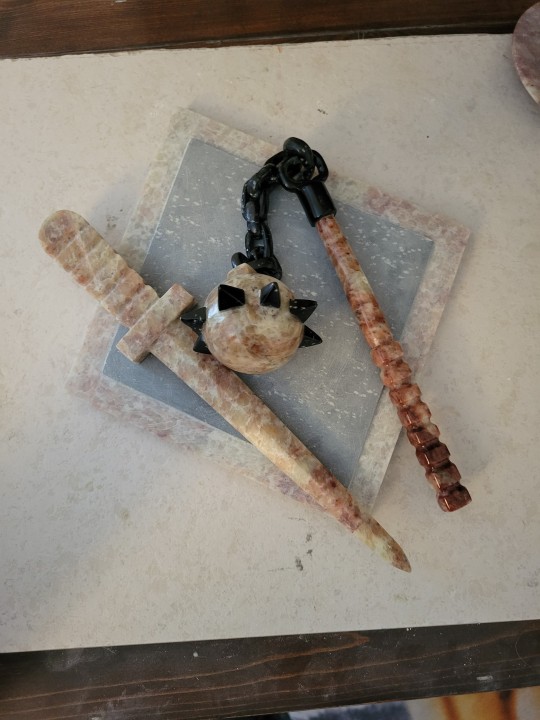#ancient weapons
Text
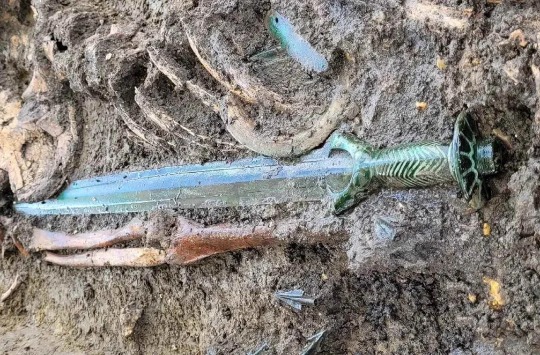

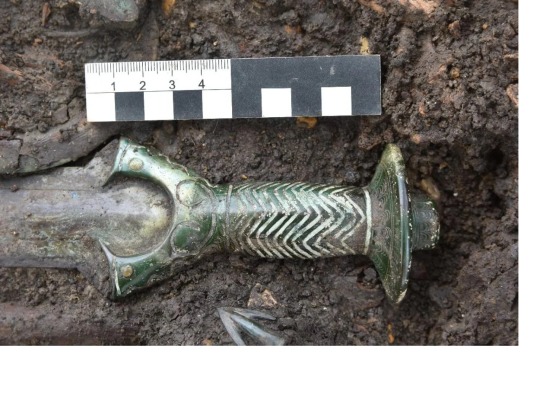
A 3,000-year-old bronze sword that was unearthed in Germany.
Via Reddit
1K notes
·
View notes
Text

Clovis point, fashioned from chert and belonging to the Clovis culture (so named from early 20th century archaeological finds near Clovis, New Mexico) that spread throughout North America following the Last Glacial Period. Clovis points are distinguished by manufacture through the pressure flaking technique and by fluting near the base. Manufactured between 11,500 and 9,000 BCE and found in Sevier County, Utah; now in the Natural History Museum of Utah, Salt Lake City.
#prehistory#prehistoric#Pre-Columbian#Paleoamerican#Paleoindian#Clovis#Clovis culture#Clovis point#ancient weapons#archaeology#artifact#spearpoint#Natural History Museum of Utah#Stone Age
336 notes
·
View notes
Text

'Very Rare' 3,000-Year-Old Bronze Age Arrow with Quartzite Tip Uncovered from Melting Ice
Glacial archaeologists in Norway have found an arrow with its quartzite tip still attached after spending up to 3,000 years in the snow and ice.
Archaeologists in Norway's mountains have discovered a "very rare" ancient arrow that still has its quartzite arrowhead and feather fletching in place.

It's likely that reindeer hunters used the weapon up to 3,000 years ago, according to archaeologist Lars Pilø, who heads the Secrets of the Ice project in the Jotunheimen Mountains of central Norway's Oppland region.
While archaeologists with the project have previously found human-made hunting blinds where hunters hid while targeting reindeer, the newfound arrow wasn't unearthed near one.
"There are no hunting blinds in the immediate vicinity, but this arrow was found along the upper edge of the ice, so the hunters may simply have been hiding behind the upper ridge," Pilø said in an email.
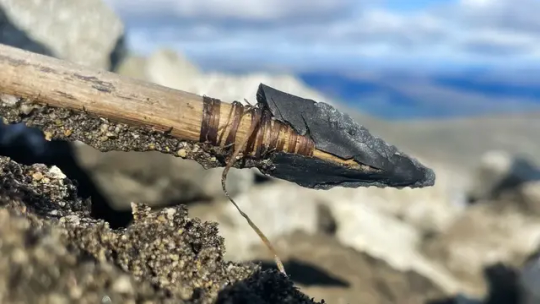
Secrets of the Ice glacial archaeologist Espen Finstad discovered the arrow on Sept. 13. Due to human-caused climate change, the snow and ice in the Jotunheimen Mountains is melting, exposing artifacts from hundreds to thousands of years ago. If archaeologists don't find these human-made items quickly after being exposed, the artifacts can deteriorate in the elements.
Finstad found the arrow during a targeted survey, when he and colleagues "checked newly exposed areas along the edge of the ice," Pilø said.
An analysis revealed that the arrow's shaft was made of birch and that it still had an aerodynamic fletching with three preserved feathers. Hunters use fletching to help guide the arrow in flight, but these typically decay over time.
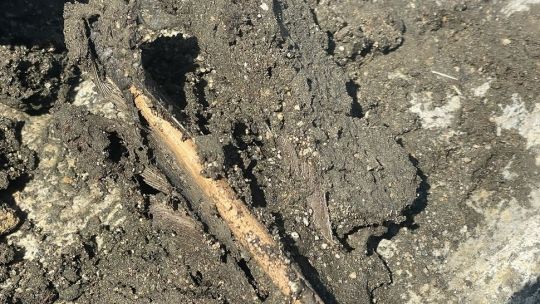
The quartzite arrowhead at the front of the shaft "is barely visible because pitch covers most of the arrowhead," Pilø said. "The pitch was used for securing the arrowhead to the shaft and to smooth the front of the arrow, allowing for better penetration. Arrows with preserved arrowheads still attached are not uncommon during the Iron Age on our ice sites, but this early they are very rare."
The pitch likely came from birch charcoal, he added.
Despite its well-preserved arrowhead and feathers, the rest of the arrow fared slightly worse. The roughly 2.9-foot-long (90 centimeters) arrow broke into three pieces along its shaft, "probably due to snow pressure," Pilø said.
By Laura Geggel.

#'Very Rare' 3000-Year-Old Bronze Age Arrow with Quartzite Tip Uncovered from Melting Ice#Norway#Jotunheimen Mountains#Secrets of the Ice project#ancient weapons#ancient artifacts#archeology#archeolgst#history#history news#ancient history#ancient culture#ancient civilizations#bronze age#bronze age history
131 notes
·
View notes
Text
So are we not going to talk about how Pluton was Nefertari D. Lili's ship?
Nefertari D. Lili went missing at sea without a trace, meaning her ship disappeared as well, right? Now go back to the Alabasta arc and the poneglyph that we saw there. Alabastian royalty had been protecting the Pluton poneglyph for generations as the country's most valuable secret.
When we reach Water 7 that is when we learn that the Pluton was a ship, which is why the blueprints were so sought after. With Pluton being lost to the sea, it makes sense why such blueprints were hidden rather than used. The blueprints were destroyed by Franky, leaving Pluton as the only ship of its caliber.
We don't know when Pluton was built other than that it was a long time ago, and we don't know where Lili went.
Nefertari D. Lili went missing around 800 years ago, which is the same age as the poneglyphs. That would mean Lili participated in the creation of the poneglyphs, more importantly, the one that would say where she would leave her ship. How else would there be a poneglyph in Alabasta marking the location of a ship in Wano?
Let's talk about bloodlines.
Luffy, Vivi, and Blackbeard are all members of the D clan, and Shirohoshi is an ancient weapon via familial inheritance. These are known facts.
Imu has photos of these four people, meaning Vivi is on the same level of threat as Luffy, reincarnation of Joy Boy, Blackbeard, weilder of multiple devil fruits, and Shirohoshi, living ancient weapon. The only reason why this would be so is if Vivi was not just a protector of Pluton but connected to it. The fact that Vivi is a member of the D clan comes second to this information. After all, there are plenty of members of the D clan who Imu doesn't have a personal picture of.
To sum it up, my theory is that Pluton was Nefertari D. Lili's ship, and will only awaken for the Nefertari bloodline. Vivi, being the last of the Nefertari bloodline, will be the one to awaken Pluton.
It would also be funny if Vivi was the key to an ancient weapon because that would mean Crocodile had the key to what he wanted but didn't know.
Anyways, kisses, see you when I'm right 💋💋💋
#one piece#Pluton#pluton op#nefertari lili#nefertari vivi#op#vivi op#luffy op#monkey d. luffy#marshal d teach#shirahoshi#neptune#ancient weapons#Imu#imu one piece#text post#joy boy#Wano#I'm right baby
98 notes
·
View notes
Text

~ Short sword and sheath.
Culture: Italic or Syrian
Period: Geometric/Latial II
Date: 9th century B.C.
Place of origin: Italy, Lazio
Medium: Bronze
#ancient#ancient art#history#museum#archeology#ancient history#ancient weapons#short sword#sword#italic#syrian#bronze#9th century B.C.
679 notes
·
View notes
Text

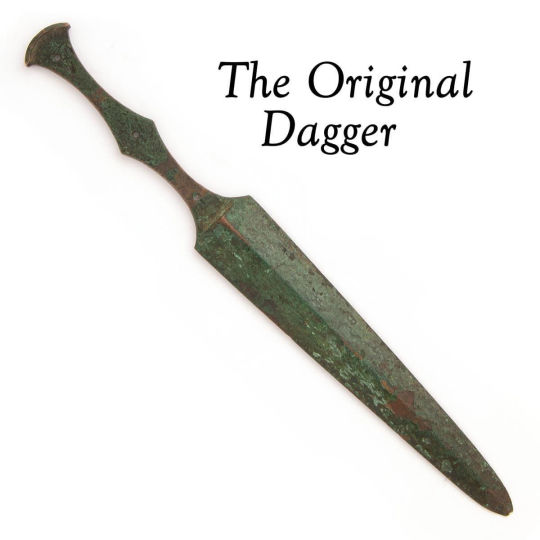


Windlass – Peloponnesian Bronze Greek Dagger
In 431 BC, Sparta, a city on the Greek peninsula of Peloponnese, declared war on Athens and its growing power. Sparta and the Peloponnesian League encircled Athens and destroyed its food supply. Athens brought its population inside the city walls, creating a disastrous situation that resulted in a plaque wiping out a third of its people and army, including General Pericles and his sons. Sparta became a leading power in Greece. This dagger is copied from an original in our possession (which is pictured above) that dates from the 9th -7th century BC-older than the Peloponnesian War but a design that was still in vogue at the time.
This Greek dagger is based on an original and its blade is bronze with a full tang like its historical example. The original likely had wood scales (which would have rotted). Windlass has instead used bone because of how attractive the material and color contrasts with bronze. The handle is very slim, but surprisingly durable due to its full tang construction and the grip is scalloped to aid grip during a thrust. The crescent-shaped pommel is an integral part of the tang and is flush with the scales. Windlass designed the sheath to be worthy of nobility (the original dagger doesn’t have one), with a highly embellished bronze throat and tip and three square medallions. The scabbard has a wood core and is covered with leather. A bronze ring is attached for lashing the sheath to a belt. A truly unique weapon suitable for any historical collection!
Please Note: We can sharpen the blade, but please be aware that the edge of the blade will be bright and lighter in color than the rest of the blade. Also, even though it is sharpened it is bronze and will not stay sharp for as long as a steel dagger would and may dull quickly.
#Kult of Athena#KultOfAthena#New Item Wednesday#Windlass Steelcrafts#Peloponnesian Bronze Greek Dagger#dagger#daggers#Knives & Daggers#weapon#weapons#blade#blades#Ancient Knives & Daggers#Ancient Daggers#Ancient Weapons#Greece#Greek Daggers#Greek Weapons#new item#new items#Peloponnese#Athens#Sparta#European Swords#European Weapons
56 notes
·
View notes
Text

Scythian archer with his bow, quiver and gorytos. Illustration by Sammy33/Shutterstock.
Learn more / Daha fazlası
Gorytos https://www.archaeologs.com/w/gorytos/
#archaeologs#archaeology#archaeological#dictionary#history#scythians#archer#bow#quiver#gorytos#weapons#ancient weapons#illustration#arkeoloji#tarih#sanat#art
39 notes
·
View notes
Photo


The kpinga was a throwing knife (shongo) used in the Congo and South Sudan in the 19th Century. Though it looks strange, the fact it has such a strange asymmetry is so that that when thrown, it is weighted around a central axis, causing it to spin in mid-air to make it travel farther.
486 notes
·
View notes
Text
Pluton theory
Pluton is not a ship! it's this guy.

It was created over 900 years ago, right before the void century, and still works to this day. The government really wanted it destroyed. They would have known it was the ancient weapon because
When Franky was flipping through the Pluton blueprints at Enis Lobby, Kaku and Lucci both immediately recognized it at a distance. This is important because even if it was a ship, most ships would have similar shapes and thus blueprints. But a giant mecha and a ship look nothing alike!
Plus, going with the theory that the ancient weapons are sea, sky, and land based; we already have a sea weapon with Posidon. How is a ship supposed to help on dry land?
Which means that all the hints we've been getting that Franky has been building Pluton are correct, but it's not the Sunny that is Pluton. IT'S GENERAL FRANKY!!

We'll probably get confirmation of this soon, as Frankey would Definitely recognize the robot when it gets out of the scrap heap.
#one piece#pluton#one piece spoilers#headcanon#theroy#franky#void century#ancient weapons#dr vegapunk
22 notes
·
View notes
Text
Now with Chapter 1086 officially released: It is basically confirmed that the thing that destroyed Lulusia is Uranos. And you know what? I think Uranos will be similar to Laputa in Ghiblis Castle in the Sky. It just fits perfectly!
I mean this movie in general could be set in One Piece. Laputa is Uranos, Sheeta is a descendent of a Celestial Dragon, Pazu is a D., Dola is a pirate Captain (in my headcanon Dadans sister). I wanted to do a crossover of Castle in the Sky and One Piece for ages but now is the perfect opportunity to at least talk about the similarities, even if I don't have time to draw anything.
#one piece#one piece 1086#one piece 1086 spoilers#one piece spoilers#castle in the sky#laputa#ancient weapons#I love Castle in the Sky#it's my favorite Ghibli movie#ghibli movie
33 notes
·
View notes
Text
Lateral Swing Shot!
It looks relatively simple, but the timing is a little tricky at first. And then there's issuing enough force to penetrate an object with relatively loose suspension!
8 notes
·
View notes
Photo






Rare Byzantine Iron Paramerion Sword with Religious Script
Ca. 1300-1400 AD
A well-preserved paramerion sword with a characteristic single-edged blade of slight curvature, with a religious script running along the outer edge. A paramerion is a distinctive form of saber sword, used by both foot soldiers and cavalry.
Size: L:1055mm / W:35mm.
#Rare Byzantine Iron Paramerion Sword with Religious Script#Ca. 1300-1400 AD#ancient sword#ancient weapons#ancient artifacts#archeology#archeolgst#history#history news#ancient history#ancient culture#ancient civilizations
186 notes
·
View notes
Text


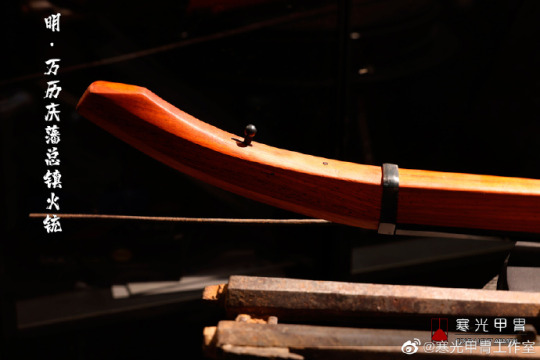




Old-school matchlock gun reproduction of the Ming dynasty item from Qingfan (慶藩). The original dates from the Wanli period. It is the first Ming matchlock gun in true sense.
Prototypes are on display at the Xuzhou Museum (徐州博物館).
Photo: ©寒光甲冑工作室
#chinese martial arts#chinese warfare#ming dynasty#ancient china#chinese history#Wanli period#wanli#matchlock#ancient weapons#ancient warfare#medieval#martial arts#chinese military#military#ancient warrior#historical
7 notes
·
View notes
Photo

https://archive.org/details/Grafton_Dover_Arms_And_Armor_R.pdf
105 notes
·
View notes
Text



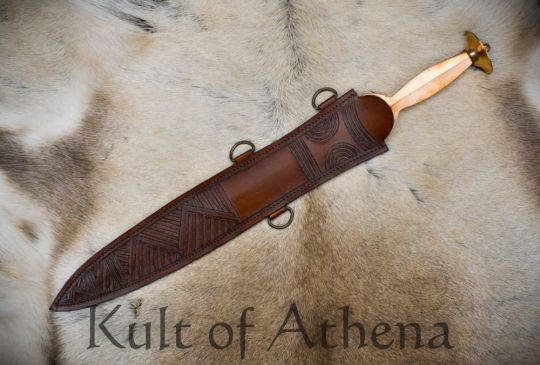
Deepeeka – Ancient Aegean Naue II Sword with Bronze Hilt
A truly ancient sword, the Naue II type swords were first created and used for ancient warfare almost 3,500 years ago around 1450 BC. Originally made entirely of bronze, these robust and long-bladed (for the time) swords which feature a hilt of organic material being riveted and pinned directly to the blade tang were in use for over 700 years and they bridged the gap between the bronze and iron ages with later designs having sword blades crafted from iron. These swords could be seen everywhere from northern Italy to the far ends of the Mediterranean and were most prominent around the Aegean.
This reproduction of an ancient Naue II sword has a blade of tempered, modern steel for durability and reliability. Its hilt is formed from bronze which is riveted directly to the thick blade tang for a very sturdy overall construction. Included with the sword is a tough leather sheath with hand-embossed and tooled design and antiqued hanging rings that allow for it to be worn vertically or at an angle with a baldric set up (sword belt not included).
#Kult of Athena#KultofAthena#New Item Wednesday#Deepeeka#Ancient Aegean Naue II Sword with Bronze Hilt#Ancient Aegean Naue II Sword#sword#swords#weapon#weapons#blade#blades#European Swords#European Weapons#Ancient Swords#Ancient Weapons#Bronze age#C60 High Carbon Steel#Battle Ready#Greek Swords#Greek Weapons
16 notes
·
View notes

